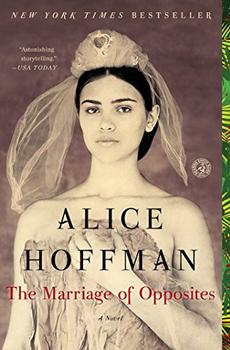Reading Guide Questions

Please be aware that this discussion guide will contain spoilers!
Introduction
From the
New York Times bestselling author of
The Dovekeepers and
The Museum of Extraordinary Things comes a spellbinding tale of forbidden love, family secrets, and unimaginable beauty. Set in St. Thomas in the early 1800s,
The Marriage of Opposites follows one of history's lesser known women: headstrong and rebellious Rachel Pizzarro—the mother of one of Impressionism's founding artists, Camille Pissarro.
Topics and Questions for Discussion
- Discuss the title. Which marriage or relationship does "The Marriage of Opposites" refer to? Where in the novel do you first recognize the title's significance?
- In Chapter 1, Rachel says, "Perhaps that was what my mother disliked most. I resembled her. I could not help but wonder if for some women, that was the worst sin of all." Discuss Rachel's relationship with her mother, her own stepchildren, and female relationships around her. What sort of resemblance does she mean? Compare these relationships with the one Rachel has with her son, Camille.
- "... on this island, strength was a necessity" (page 22). Consider the power dynamics in the novel, from mental strength to willpower, physical strength versus financial dominance. Discuss what is meant when Rachel's father tells her that her marriage is "a combining of strengths" (page 27). For these characters, which strength is most valuable?
- Discuss the importance of identity in the novel. What are the roles of religion, race, and class as they contribute to each character's definition of self?
- Weather and the natural world figure strongly in The Marriage of Opposites. Consider how Rachel, Frédéric, and Camille view the rain and the heat. Discuss the differences or similarities in their points of view. How do descriptions of weather define life on St. Thomas and life in Paris?
- There are many sorts of love that are "forbidden" in the novel. Why does the community disapprove of Rachel and Frédéric's relationship? Why does Rachel later disapprove of her son's relationship with a working member of her household, when she herself has been so close to Adelle and Jestine?
- The mystical world plays a key part in life on the island. Often, characters speak of spells, spirits, and ghosts and use herbs to cure emotional and physical distress. Compare the role of spirituality on St. Thomas and in Paris. At what point does the mystical distinguish itself from Jewish tradition?
- The relationship Madame Halevy forms with Camille? Why do you think he is so interested in her and the stories she has to tell?
- Discuss this line from page 272: "But a servant, no matter how beloved, was not a friend, and a slave was a shadow, nothing more." What did you learn about slavery and servant culture in St. Thomas in this novel? Do you feel it is similar to American slave-owner, servant-worker relationships? Can there be true friendships in a relationship where one person has more power than the other?
- "Always pay heed to the woman who comes before you. If he's treated her badly, he will treat you much the same" (page 231). How does Rachel's understanding of Madame Petit affect the way she raises her children? Does this statement grant Lydia any sense of clarity on her father? Discuss how Rachel, Lydia, and other women understand the roles of the women who came before them.
- The Marriage of Opposites contains a fluid definition of family. Many characters, both male and female, have illegitimate children who are unacknowledged, abandoned, or cast off. Discuss the different manifestations of family in this novel. Were you surprised to learn who Aaron and Jestine really are? Why or why not?
- In the afterword, Alice Hoffman explains briefly how she came across the story of Pissarro's mother. How was your reading of the novel or opinion of it affected by the knowledge that this is based on a true story?
Enhance Your Book Club
- "Like the breakfast he'd had, the landscape was a familiar part of him that surfaced in his dreams and in his art" (page 257). With your book club, research Camille Pissarro's artwork on the Internet or, if you are able, visit a local museum that features his work. Discuss how the novel's setting is manifested in his work. Is The Marriage of Opposites characteristic of Pissarro's style? Are there paintings that remind you of scenes in the novel?
- Select one of Alice Hoffman's other works, such as The Museum of Extraordinary Things or The Dovekeepers, for your next book club meeting. How are these works similar or dissimilar to The Marriage of Opposites.
- Research the colonization of St. Thomas—especially the history of the Jews there—and native spiritual culture. Does anything in your research surprise you?
- For your next book group, select a book about other "invisible" women in history. Try to discover the stories of women in your own family. Interview older relatives or read about history of women in your own culture.
- To learn more about Alice Hoffman, visit her website at www.alicehoffman.com or connect with her on Facebook at www.facebook.com/alicehoffmanauthor.
Unless otherwise stated, this discussion guide is reprinted with the permission of Simon & Schuster.
Any page references refer to a USA edition of the book, usually the trade paperback version, and may vary in other editions.

 Book Reviewed by:
Book Reviewed by:





